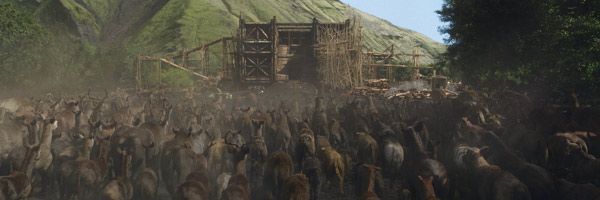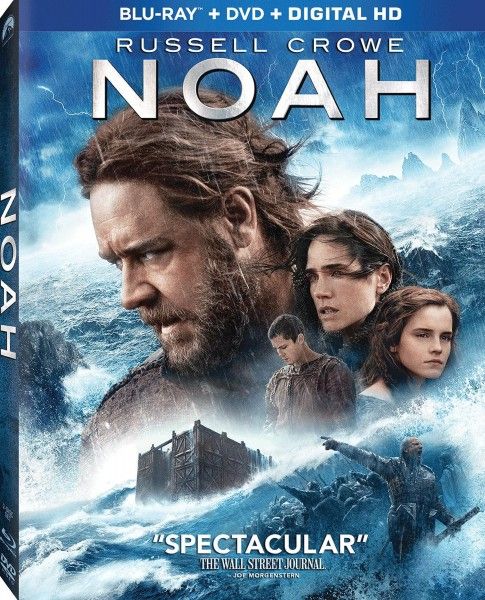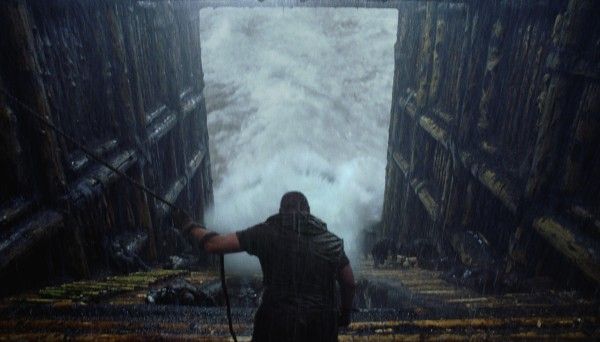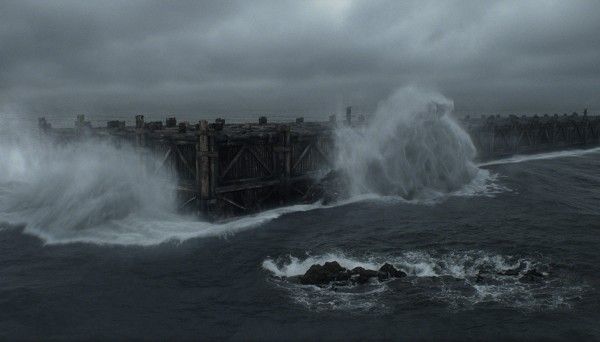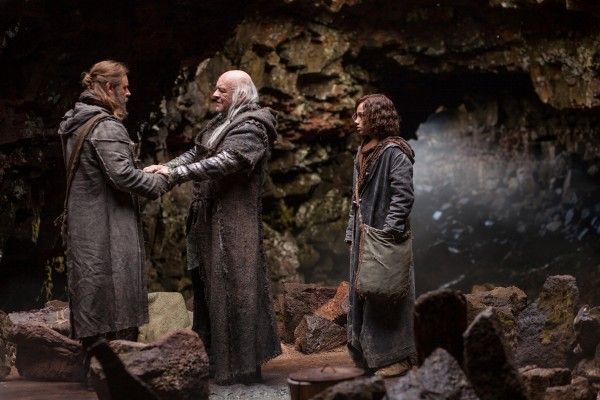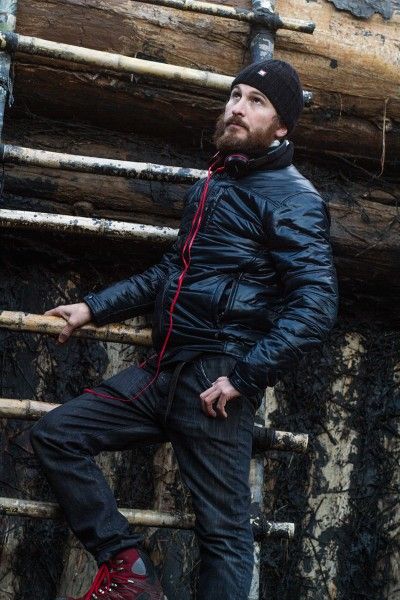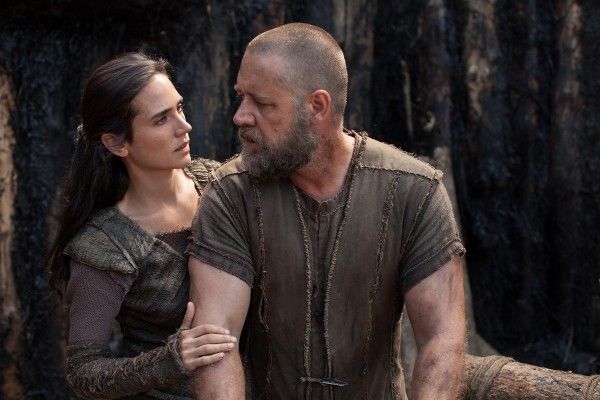The visually stunning global hit Noah, from director Darren Aronofsky, is now available on Blu-ray/DVD. The film is an action spectacular with impressive visuals that could have only been brought to life through a collaboration between the visionary filmmaker and Industrial Light & Magic.
Visual effects supervisor Ben Snow (who’s also worked on King Kong, Terminator Salvation, Iron Man 1 and 2, and Pirates of the Caribbean 4, and is currently working on Avengers: Age of Ultron) recently spoke to Collider for this exclusive phone interview about how daunting it was to take on the visual effects for a movie as epic as Noah, bringing the Bible to life in a respectful way, working on effects that are specific to the personality of each individual character, the biggest creative challenges on the film, how visual effects have most advanced in the last few years, and how difficult it is to distance yourself from the final product enough to really enjoy it when it’s all put together. Check out what he had to say after the jump.
Collider: How daunting was it to take on the visual effects for a movie like Noah, knowing that you’re not only trying to do the story justice and you’re trying to service what the filmmaker wants, but you’re also tackling the Bible and bringing it to life?
BEN SNOW: Absolutely! It was definitely a project at Industrial Light & Magic that we really wanted to do. We really wanted to work with Darren Aronofsky. He’d visited us a couple of times and we’d met him and talked with him. We knew that he would have a unique and interesting take on the subject matter. I felt that the filmmakers really respected the source, and they consulted with religious leaders. So, I felt like there was a seriousness with which they approached the story, which meant that it was going to be respectful, as well as being a really unique take on the Biblical epic. At least, we wouldn’t be hated for it.
Was the grounded feel of the story something that was important to you?
SNOW: I think it really did bring out the themes and the ideas that are inherent in the story, and it asked questions about the story. That was really one of the appealing things. I researched things really thoroughly. Even with some of the wilder creatures, like the fallen angels, or The Watchers in the film, they really thought a lot about the backstories, why they’re like they are, and how their fate reflects itself in the way they look. It was a really thoughtful approach. On top of that, with the more fantastical elements of the film, we tried to root everything in a sense of reality and base it on the photography we’d shot in Iceland and on location. We just tried to root everything in realism, as well as exploring and showing some of the wonderful biblical visions and things like that.
This really is the type of job where, if you’re good at what you do, the whole point is for people to forget that what they’re look at is effects. Does that make the job ever feel a bit thankless, or do you consider it a job well done, if an audience believes that what they’re watching is real?
SNOW: It’s an interesting two-edged sword. The noblest and most high goal for what we do is for them not to notice and for them not to think, “Oh, that was a visual effect.” So, I really like working on very realistic-looking stuff, for that reason. But I also like the flashy visual effects that make you go, “Wow, it couldn’t be done any other way than visual effects,” and the opportunity to create fantastic and cool looking images. So, it’s a double-edged sword. I definitely aspire to make the images look as photo real as I can, and I believe everyone at ILM really strives to that. But, it’s also nice to have your work showcased. It’s an interesting thing. Honestly, if you regard it as trying to serve the story and keep the audience immersed in the story, that’s probably the best way to approach it. The truth is that, every year, audiences get more sophisticated in their expectation. And what gets achieved in the world of visual effects gets better and the envelope gets pushed. So, it’s a moving standard. You can’t really ever rest.
As a result of all of that, do you enjoy making special features and behind the scenes features available to audiences on the Blu-ray, so that they can see how much work is involved, or do you feel like that takes away from the magic of it all?
SNOW: Probably like many people who end up doing something they love, I was a fanatic for knowing about this stuff, when I was growing up and in high school. If you look at an artist like Ray Harryhausen, he was quite secretive. And magicians are pretty secretive, but I was obsessed with stage magic and finding out how they did their tricks. With what we do, with computer graphics, people say, “Oh, they just did it all on a computer,” even though it’s actually still incredibly complicated and tricky and very, very clever. It becomes this glib answer to things. So, it’s almost impossible to exactly explain to a non-technical audience, or even a fan audience, “This is how we did that.” Honestly, you end up with software and really good artists using that software, and that’s where the magic happens. It’s in the artistry with the filmmakers making a story and working out how to use visual effects to tell that story, and artists being able to get the best out of these tools and work out what new tools they need, so they can create those new tools to create images that may not have been thought of or done.
In doing something like Avengers: Age of Ultron, where you have visual effects that come from the specific personality of each of the characters, and you have so many different characters, do you then collaborate with both the director and the individual actor?
SNOW: Absolutely! I think that’s true of many projects that we do. On the Iron Man films, which I did, going back to Iron Man 1, we definitely had that collaboration, in bringing it to life. But, I think that’s true on any film. On Noah, Darren brought in some of the choreographers and dancers from Black Swan to explore how The Watchers would move. They came out to Industrial Light & Magic and worked with our animation team. We did some real-time motion capture tests on set, where we were able to have them actually explore different ways of making them move in real-time. The technologies and the way that we approach getting artists with different skill sets, like movement and acting, to collaborate with our animation teams, it’s really about doing interesting things. It’s about taking motion capture as a starting point, and then building off of that and tweaking it. It’s something we’re getting better and better at, with each project. It’s an exciting area.
Even if you’d had some experience with the things you had to do for Noah, everything was on a much bigger scale. What were the biggest challenges that you had to tackle?
SNOW: The thing about Noah is that you had the creative sensibilities of Darren Aronofsky factored in, as well. It was always going to be a unique take on the material and it was always going to be very individualistic and definitely reflective of his sensibilities and style. That was one of the big reasons that we really wanted to work on it. When it came to exploring designs for The Watchers and even for all of the animals, because he didn’t want to do the typical Noah’s ark, he definitely wanted to explore ideas. It was a big challenge, creatively, to come up with these things that would work. There was a big exploration process with the design, and coming up with the design. That was definitely one of the biggest challenges on the film.
We also knew that we’d be faced with a challenge with the deluge. I’d worked on big water effects before, going back to Twister and Deep Impact, but we had to build on all of that experience, going back many years, to create the granddaddy of all storms. It is the deluge, so you really want to come up with ideas to make that interesting and unique. The script had these ideas from the Bible, where the waters of the ground would rise up, as the waters from the heaven would rain down. So, we had these geysers bursting from the ground. We wanted to add something that would make it as biblical as we could. It was a predicted challenge, but it didn’t make it any easier.
We knew we were going to be faced with it, and we knew we were going to be faced with big battle scenes, but we also had really interesting one-off things, like Noah’s vision or when The Watchers are relating the history. Those were all really wonderful creative opportunities for us that used every technical tool-set and all of our creative skills to create something unique that fulfilled the vision that those shots demanded.
How would you say that visual effects have most advanced over the last few years, and what have you been able to do, in the last year, that you couldn’t do a couple years ago?
SNOW: I think that we’ve gotten a lot better with on-set capture, motion capture and facial capture. They’ve definitely improved a lot with the different technologies. Industrial Light & Magic has worked on improving our water tools, over a series of films, starting with Pirates of the Caribbean 4, Pacific Rim, and then Battleship. And then, there were all of the individual challenges of Noah, like the lava that forms The Watchers. So, I do think that we’re a lot better now with things like fire, dust and water. The other thing that’s really improved is that we’ve realized that we need to have a much more firm physiological understanding of how creatures and beings and people work and move, and how we have to reproduce that more closely, in our computer simulation, so that you really see muscles moving properly. You want to make sure the facial structure is accurately depicted.
When you’re so immersed in making and having a hand in something so epic, can you sit back and watch it, when it’s all done and put together, and be proud of having had a hand in that, or do you always see the things that you could have changed or done better?
SNOW: It’s funny, the first time I saw the finished film – I’d seen it a couple of times in progress – I was so tense. It was at one of the premieres. I was on location, so I got to go to one of the U.K. premieres for it, and I was very tense. The audience had a good reaction, but I didn’t really enjoy it. And then, I got the opportunity to see it again at the London premiere. That was a big, exciting premiere that they had in Leicester square with a flood-colored carpet, and all of the actors were there. I actually got to take some friends to see it, who really didn’t have any idea what they were in for, and I really enjoyed it. I was able to sit back and say, “This is really good. The film works really good.” If you let a bad shot through, you’re the one that’s going to have to look at it, for the rest of your life, or look away. So, I really try not to have that shot where I have to look through my fingers, but it’s hard. It’s a challenge. But it’s easier to turn my critical thoughts off to other people’s work, and sit back and enjoy stuff. I can actually do that pretty well. With stuff I’ve worked on, it’s a lot harder to just sit back and enjoy it, until maybe a few years later.
Noah is now available on Blu-ray/DVD.

